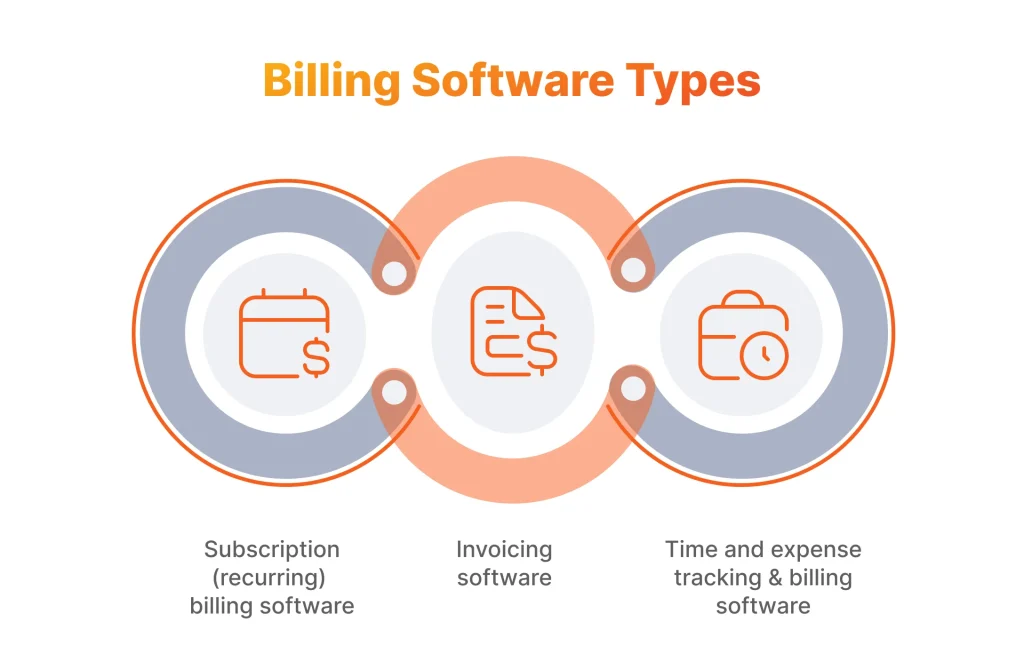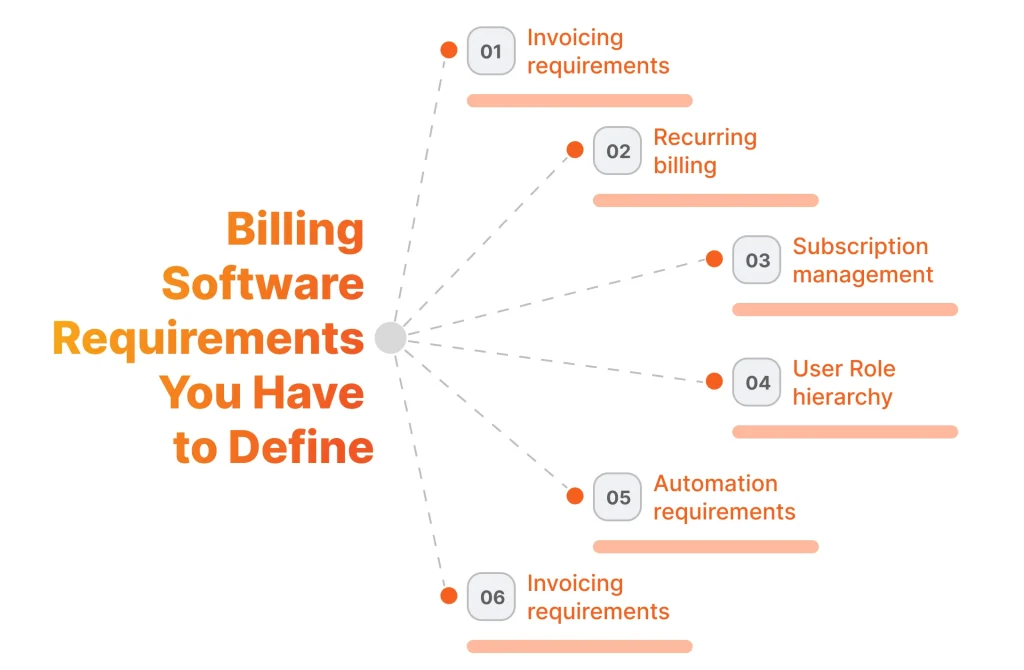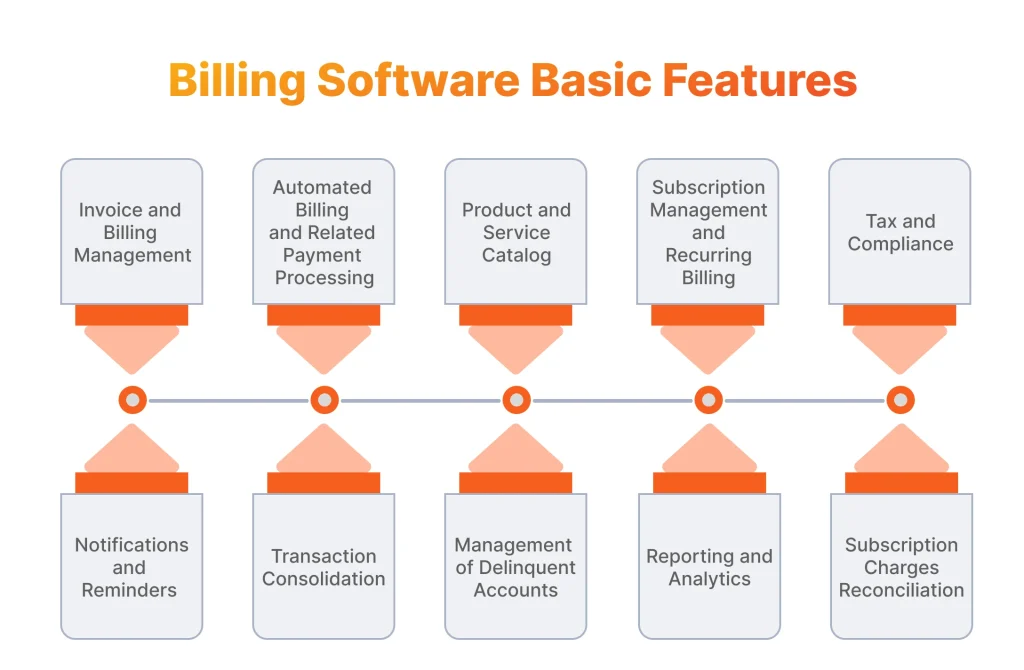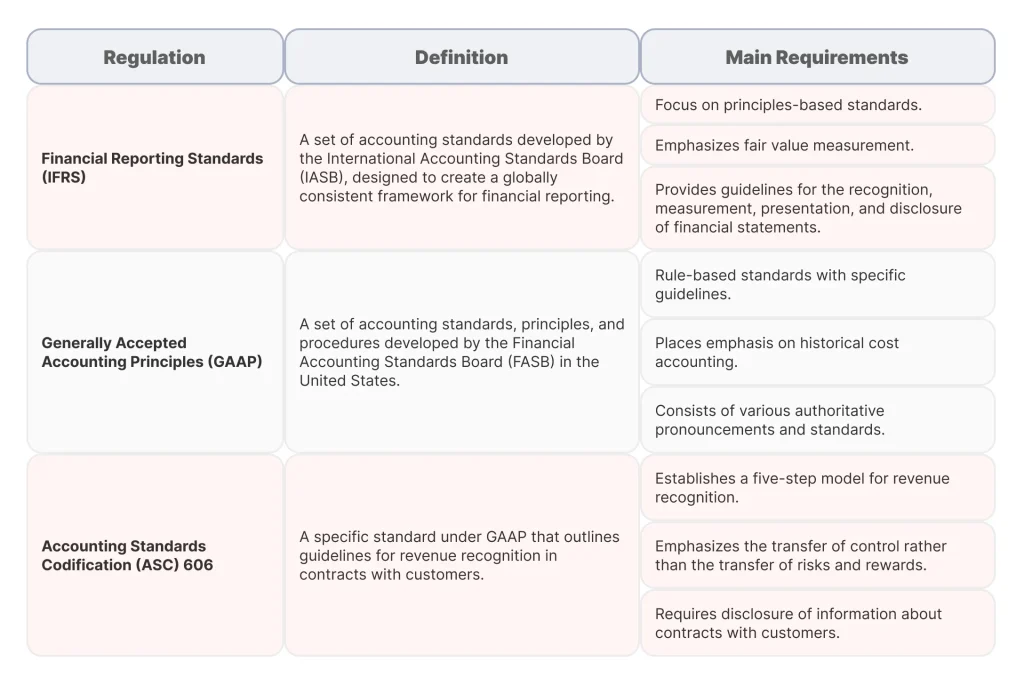For virtually any business that needs to collect revenue at some scale, billing is a crucial process that can either improve and expedite their cash flows or become a source of revenue leakages, payment delays, and serious customer dissatisfaction.
Being driven by the goal to avoid such negative consequences, companies from different industries opt for developing a billing system from scratch and fully align the newly-created solution with their business needs. This article will help you do exactly this – gain a firm idea about the meaningful aspects of billing software development and the kind of interactions you as a client should establish with your development partner to make sure the solution delivered meets the specified requirements and seamlessly aligns with your business goals.
Decide on the Type of Your Billing Software
Before discovering how to make billing software step-by-step, you have to decide on the type of the billing app you need. Next, it will become a foundation to effectively compile the list of required features. Determining the type of the billing application that best fits your needs will also help your billing software provider tackle your business needs more proactively.

Below are three basic types to choose from but keep in mind that the functionalities of each type may overlap as well:
- Custom invoicing software – a software solution that allows issuing invoices and generating related reports.
- Subscription (recurring) billing software – a software application that allows you to perform automatic billing of multiple billing events in accordance with a predefined scenario throughout the customer lifecycle.
- Time and expense tracking and billing software – a software application that provides time and expense tracking for client projects, as well as time- or flat fee-based invoicing and billing.
Define System Requirements
Any complex software development project starts with defining the requirements for the system to be built, and customized billing software development is no exception. Let’s now review the different groups of requirements associated with the main functional capabilities of a billing software application and find out what should be paid attention to while dealing with these requirements.

Invoicing
First, one should categorize and describe all the projects and services your business offers, as well as allow for the ability to add new product and service categories. Next, it is essential to define your requirements for the invoices that need to be issued to bill for these products and services.
Also, keep in mind that in defining the invoices-related requirements, it is important to necessarily indicate the formats your invoices need to be issued in. Besides, the user must be able to re-use any existing invoices, i.e. create new invoices by modifying existing ones.
As to the requirements that cover the delivery of invoices to your customers, they must list all the ways in which these invoices can be issued to them, like SMS, email, and any other possible channels. Additionally, it may be useful to allow for automatic sending of invoices and delayed sending of invoices at a specified date or within a specified date range.
Recurring Billing and Subscription Management
In order to implement billing support for the products and services that are billed for multiple times, the functionality of your billing solution must include a recurring billing capability that would allow you to bill for a product or service at set modifiable intervals.
Also, if the nature of your business requires the ability to work with subscription plans, this functionality should also be outlined in your SRS document. Implementing a Subscription Management capability allows you to automatically bill for a series of billable events within one of the usage scenarios (or subscription plans) that you offer.
There are two things to pay attention to here: firstly, your system must bill only for the period that the customer has been using your services. This means that the application must run the corresponding checks. Secondly, all the subscription packages must be completely modifiable – you must be able to update or expand them at any time and then automatically bill for any new billable events added. Such subscription management and billing functionality is a part of BlackHawkNetworks (BHN) Aggregated Merchant Portal (AMP) we have recently developed.
Tax and Compliance Regulations
You can conveniently incorporate in your requirements for tax calculation functionality to automatically calculate any taxes due to be paid from the sale of the products or services your invoices cover.
To do so, you should indicate this as a requirement, stating that your tax calculation module must calculate taxes for all your products and services for all your relevant jurisdictions while taking into account any applicable exemptions and thresholds. One must be able to easily configure the taxation rules with a view to keeping them up to date. In this way, we have created tax calculation functionality for an Israeli real estate company with dynamic recalculation and multiple parameters embedded.
User Role Hierarchy
Just like with any other solution, your SRS document must describe the user hierarchy for your future billing software.
More specifically, it must list all the user roles and specify the corresponding permissions for these user roles. Among other things, this means that one should indicate which of the user roles will have authority over your bank account. For example, your user hierarchy could include:
- Administrator, who can manage user access, assign roles to new users, and reassign roles to existing users.
- Accountant, who manages accounts, balances, and the collection of funds.
- Sales Manager, who has access to the information on incoming payments.
- Configuration Engineer, who manages the billing rules and performs overall system maintenance.
- Regular Users, whose rights should be individually defined depending on your business specifics.
Please note, that in the event that your business has any resellers, one should envisage this role too. Most probably, the Reseller role should be associated with the ability to add customers, issue invoices, and collect payments. In this regard, your authorized staff must have the ability to supervise the reseller-related invoicing and payments, while your solution must also calculate any related taxes that are due to be paid by you.
Some Other Important Requirements
There are some other requirements that one should make part of your SRS document. If you work with more than one currency, one must indicate this too: list all the currencies you are going to use and add the ability to expand the list in the future. Also, you should clearly list and describe all the billing and payment processes that you want to be automated, like the sending of payment reminders, invoice generation, and so on.
Shortlist the Necessary Software Features
Based on the business needs and related requirements you’ve defined, your provider of custom billing software development services will come up with a list of the functional capabilities your solution will include. You should thoroughly discuss this list with them, use your knowledge of your business domain and business situation to augment the contents, and agree upon the functions listed.

The functions that a full-blown billing software solution would likely include are:
- Invoice and Billing Management – functionality that allows you to create invoices from scratch and based on existing invoices both manually and automatically.
- Automated Billing and Related Payment Processing – functionality that allows you to automatically send the created invoices to customers using different channels, as well as conveniently track all the incoming customer payments, made to pay these invoices.
- Product and Service Catalog – a comprehensive listing of all your products and services you need to issue invoices and bill for that allows easily selecting such products or services and adding them to invoices.
- Subscription Management and Recurring Billing – a functional capability that automatically bills a customer during their lifecycle in accordance with a selected subscription package, or performs automatic billing for a recurring service.
- Tax and Compliance – functionality that calculates all the taxes that are due to be paid from the sales your billing activities are associated with, including the sales tax, VAT, and any other taxes that you are to pay in your jurisdiction.
- Notifications and Reminders – functionality that allows automatically sending various notifications and payment reminders to specific target audiences at specified dates, or when some specified conditions are met.
- Transaction Consolidation – a capability that merges multiple purchases of products and services into a single invoice.
- Management of Delinquent Accounts – functionality that makes it easy to identify delinquent accounts and send relevant payment reminders or take some other relevant action.
- Reporting – a reporting capability that allows generating collection reports and tax summaries.
- Reconciliation of subscription charges and non-recurring charges – this feature allows for seamlessly aligning subscription-based charges and non-recurring charges within the billing software, providing accuracy and transparency in financial transactions.
Choose the Right Technologies
At the next step, proceed with choosing the technical stack that will be used to build billing software. Our practical experience in fintech software development suggests that the next tools can be strategically chosen to develop a robust and secured billing solution.
- Programming language: Java. Java programming language provides a secure and scalable foundation, crucial for handling sensitive financial data and accommodating the growing transaction volumes inherent in fintech applications.
- Backend framework: Spring Boot. Spring Boot is a widely adopted and microservices-friendly framework for building Java-based solutions. The Spring ecosystem provides comprehensive features, including security, data access, and transaction management, crucial for fintech applications.
- Frontend framework: Thymeleaf and React.js. Thymeleaf is a server-side templating engine that integrates seamlessly with Spring Boot. If a more interactive user interface is desired, React.js can be introduced alongside Thymeleaf for building dynamic and responsive components.
- Message queue: Apache Kafka. Apache Kafka is a distributed event streaming platform that can be employed for asynchronous communication between components of the billing systems. It ensures reliability, fault tolerance, and real-time data processing, which are crucial for payment-related operations.
- Database: PostgreSQL. PostgreSQL is a robust open-source relational database known for its ACID compliance and support for complex queries. It integrates seamlessly with Java through JDBC and Hibernate, providing an excellent foundation for storing and retrieving financial data securely.

Dmytro Nesterenko
Senior Software Engineer at SPD Technology
“PostgreSQL is a good choice, but at the same time MySQL/MariaDB are also very widely used because of their simplicity and slightly better performance on the high load.”
Implementing Invoicing Logic
The ability of a billing solution to seamlessly encompass your business needs hinges significantly on how fully and how meticulously you implement the invoicing logic required in your case. That is why it makes sense to spend more time on defining your invoicing tool logic and make sure none of the important steps are omitted or dowplayed.
We would suggest the following checklist to ensure the invoicing logic implemented fully meets your business needs:
- Specify pricing structures, discounts, and tax rates associated with each product or service offered by the business
- Define the tax regulations applicable to the business. Make sure the tax rates are implemented for all the jurisdictions you operate in.
- Specify how the taxes should be calculated and applied to your invoices.
- Specify all the required workflow automation features that will streamline the payment processes and reduce the amount of manual effort.
- Detail the subscription packages that the system needs to support.
- If this makes sense, implement billing calendars with varying timeframes, like, for example, once a month, once in three months, once a year.
- Implement automatic recurring invoicing.
- Implement advance invoicing.
Following this detailed invoicing logic implementation checklist, we have designed an invoicing & billing subsystem for Pie Insurance, one of our major customers in the Insurtech domain. The billing subsystem we developed allows for creating, updating, and tailoring billing plans, including specialized payroll reporting plans. It also facilitates the recording, tracking, and reporting of premium billing, payment plans, and received payments.
Furthermore, our solution empowers Pie Insurance to accurately monitor and report on the equity of each policy, automatically executing policy cancellations in alignment with equity calculations. Addressing the nuanced regulatory landscape, where each U.S. state has distinct cancellation-related rules, the system adeptly tracks non-payment cancellations.
Integrate a Payment Gateway
Now, let’s proceed with discovering how to create billing software from the technical standpoint and integrate it into your financial ecosystem. For your billing software to be fully functional, you need to integrate it with a payment gateway, and optimally, with CRM and accounting software.
Usually, a billing solution initiates payments since billing events such as invoice generation or subscription renewal take place according to the predetermined schedule. That’s why billing software should have a payment API client (a software component that interacts with API by making HTTP requests to API endpoints) enabling its communication with a payment gateway.
When it comes to payment gateway integration, it’s best to opt for a RESTful API-based approach. By leveraging the Payment Gateway’s API, we can establish a direct communication channel between the billing system and the payment service. This method ensures real-time data synchronization and facilitates a smooth flow of information during transactions.
Follow a step-by-step path of payment gateway integration being guided by our expert article!
Also, be aware that maintaining consistency between the billing system and the payment gateway is crucial. The proven way to address this challenge is to implement a reliable data synchronization mechanism to ensure accurate and up-to-date information on both ends. With these specific issues of integrating a payment gateway into a custom-developed billing system, you are welcome to follow the next step-by-step algorithm:
- Establish API credentials
- Building the API client
- Implement secure communication
- Integrate payment methods
- Incorporate error handling mechanisms
- Ensure data consistency
- Test in a sandbox environment.
Build Secure a User Authentication Mechanism
Securing user access to an application that is used to control financial flows and the related confidential information is one of the Fintech development challenges that needs to be solved only reliably enough.
To ensure financial data security in this case, one should settle for Two-Factor (2FA) or Multi-Factor authentication only, and pay special attention to the selection of a truly reliable second factor your employees would be comfortable with. It makes sense to look in the direction of the more user-friendly biometric methods like, for instance, Iris Identification or Voice Identification, or advanced Face Recognition. In the latter case, one should check whether the solution offered has robust anti-spoofing protection against the sophisticated modern types of fraud, like, for example, 3D masks.
Ensure User-Friendly Design
Just like any business system, your billing software should have an intuitively user-friendly GUI. As the GUIs of high-scale billing software solutions often provide access to a large number of diverse functions, this may not always be an easy goal to achieve for their developers. For you to have better odds of having user-friendly GUI developed for your billing application, you should opt for a provider of bespoke software with experience in developing GUIs for feature-rich, enterprise-grade applications.
Below are some of the best practices to design user-friendly billing software:
- Implement a clear and consistent navigation structure, making it easy for users to locate essential features and functions.
- Design an uncluttered dashboard that provides a quick overview of key billing metrics and alerts.
- Provide real-time, contextual feedback for user actions. Use tooltips, notifications, and error messages to guide users through the invoicing process and address any issues promptly.
- Streamline data entry with smart form design. Use auto-fill, drop-downs, and date pickers to reduce manual input errors.
Keep Fintech Compliance Regulations In the Spotlight
Your billing software must be compliant with the main security and payment processing compliance regulations that include PCI DSS, SOC2, and PCD. Prior to the start of your project, you should become thoroughly familiar with these regulations and discuss with your software provider how they are going to ensure compliance with them.
Please also make sure that your provider of choice is capable of conducting the PCI DSS-mandated security penetration testing of your application. They must be able to test your collusion’s abilities to counter cyber attacks (SQL injections, ORM injections, and others), securely transmit credentials, securely and compliantly manage passwords, etc.
Ensure Compliance With Financial Reporting and Accounting Standards
In addition to the required security compliance, you are expected to ensure compliance with the Financial Reporting Standards (IFRS), Generally Accepted Accounting Principles (GAAP), and Accounting Standards Codification (ASC) 606.

The IFRS and ASC 606 standards aim to make sure that revenue is recognized only after it has been earned by meeting a contractual obligation. This requirement can be quite tricky to meet, for example, in the case of complex subscription plans with advance payments. For example, IFRS compliance requires that your system must allow you to:
- Identify the one or more contracts you have with the customer.
- Identify the performance obligations stated in this contract.
- Determine the price of the transaction.
- Allocate the price of the performance to the performance obligations.
- Recognize revenue when the company meets their obligations.
GAAP compliance helps recognize revenue for bill-and-hold transactions (whereby the product is sold but not immediately delivered): the revenue recognition can take place only when some condition is met.
Because of the great importance of the financial reporting and accounting standards, it is imperative that one gain a good command of them and reflect the requirements they contain in your system.
Conclusion
Billing applications represent complex software systems with complicated functionality that are heavily influenced by a host of complex regulations and need to provide compliance with them.
Correspondingly, if you wonder how to make billing software, you should first gain a deep understanding of your billing-related business needs and compliance matters. It would also be wise to partner with a tech vendor and leverage their fitech-specific expertise to build an advanced and secured billing processing solution.
At SPD Technology, we are always delighted to share our billing software development-related knowledge with those looking to improve or automate their related business processes, so you are welcome to talk to our experts!
FAQ
- How to make billing software for shops?
One should approach an experienced billing software development company that develops bespoke software and provides full-cycle software development. You should help their business analysts to gain insights into your business context and business needs so that they can architect and develop the solution you need.
- How to make billing software from scratch?
To develop billing software from scratch, you should get started by deciding on the software type you need. Depending on the type, you will be able to define system requirements, including but not limited to invoicing platform, recurring billing and subscription management, user role hierarchy and compliance requirements. Then, proceeding with shortlisting the necessary features and based on them, develop the UI of your future solution. Partnering with a billing software development vendor is the wisest decision along this way, since the tech-savvy software developers would be able to competently support you with their technical knowledge and expertise.
- How to create own billing software?
Gain an understanding of your business needs and approach a custom software development company with enough experience in your niche to create a SRS document and get the project under way.

